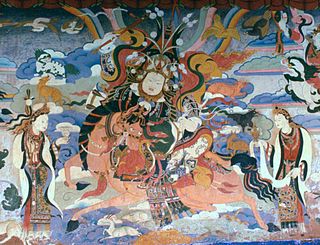
Tengri is the all-encompassing God of Heaven in the traditional Turkic, Yeniseian, Mongolic, and various other nomadic religious beliefs. Tengri is not considered a deity in the usual sense, but a personification of the universe. However, some qualities associated with Tengri as the judge and source of life, and being eternal and supreme, led European and Muslim writers to identify Tengri as a deity of Turkic and Mongolic peoples. According to Mongolian belief, Tengri's will (jayayan) may break its own usual laws and intervene by sending a chosen person to earth.

Erlik, Erlig, Erlik Khan is the god of death and the underworld, sometimes referred to as Tamag (hell) in Turkic mythology. Er means Earth, in the depths of which Erlik lives in. From the underworld, Erlik brings forth death, plague and evil spirits to torment humans and take their souls into his realm. Since Tengrism is not based on a written corpus but encompasses the experienced spiritual life of Turkic people, there are no unanimous beliefs among all Turkic people. Erlik has already been mentioned in the Orkhon writings and shows a consistent pattern as the lord of the underworld among Turkic belief systems. In Mongolian, Erlik is referred to as Erleg or Yerleg, and in Hungarian mythology he is equivalent to Ördög.

Burkhanism or Ak Jang is an indigenist new religious movement that flourished among the Altai people of Russia's Altai Republic between 1904 and the 1930s. The Russian Empire was suspicious of the movement's potential to stir up native unrest and perhaps involve outside powers. The Soviet Union ultimately suppressed it for fear of its potential to unify Siberian Turkic peoples under a common nationalism.

Ak Ana, the "Holy Mother", is the primordial creator-goddess of Turkic people and the Khanty and Mansi peoples of Siberia. She is also known as the goddess of the water. She was the consort and daughter of Kayra Han.

Etügen Eke is an earth goddess in Tengrism and Turkic mythology. She was believed to be perpetually virginal. The word "etugen" associates with woman and daughter of Kayra. Also her name may have originated from Ötüken, the holy mountain of the earth and fertility goddess of the ancient Turks. Medieval sources sometimes pair Etugen with a male counterpart named Natigai or Nachigai, although this is probably a mistake based on a mispronunciation of Etugen. In mythology Etugen is often represented as a young woman riding a grey bull.

Shors or Shorians are a Turkic ethnic group native to Kemerovo Oblast of Russia. Their self designation is Шор. They were also called Kuznetskie Tatars, Kondoma Tatars, Mras-Su Tatars in some of the documents of the 17th and 18th centuries.

Turkic mythology refers to myths and legends told by the Turkic people. It features Tengrist and Shamanist strata of belief along with many other social and cultural constructs related to the nomadic and warrior way of life of Turkic and Mongol peoples in ancient times. Turkic mythology shares numerous ideas and practices with Mongol mythology. Turkic mythology has also been influenced by other local Asiatic and Eurasian mythologies. For example, in Tatar mythology elements of Finnic and Indo-European mythologies co-exist. Beings from Tatar mythology include Äbädä, Alara, Şüräle, Şekä, Pitsen, Tulpar, and Zilant.

Tengrism is a religion originating in the Eurasian steppes, based on shamanism and animism. It generally involves the titular sky god Tengri, who is not considered a deity in the usual sense but a personification of the universe. According to some scholars, adherents of Tengrism view the purpose of life to be in harmony with the universe.

The Mongol mythology is the traditional religion of the Mongols.

Koyash is the god of sun in Turkic mythology.

Ay Ata, also known as Ay Dede, is one of the mythological entities in Turkic mythology and Tengrism. Ay Ata literally means Moon Father.

Kayra or Kaira is the creator god in Turkic mythology. He is the god who planted the tree of life called Ulukayın. Kayra is described as both father and mother, and resides in the 17th layer of heaven.
In the pantheon of Mongolian shamanism and Tengrism, tngri constitute the highest class of divinities and are attested in sources going back to the 13th century. They are led by different chief deities in different documents and are divided into a number of different groups—including black (terrifying) and white (benevolent), and eastern and western. While there generally seem to be 99 tngri, some documents propose three others, and while they are generally the highest divinities, some liturgical texts propose an additional group of 33 chief gods alongside the tngri. They were invoked only by the highest shamans and leaders for special occasions; they continue to be venerated especially in black shamanism. Chief among the tngri are Qormusata Tngri and (Khan) Möngke Tngri.

Burkut is the eagle god in Turkic mythology.

İye is a spirit in Turkic mythology who is a tutelary deity of a place, person, lineage, nation, natural assets or an animal. Although such spirits are called "masters" or "possessors", they are not necessarily subject to worship. They may be revered as sacred essence of things without being deified or even personified.

Kubai is the goddess of birth and children in Turkic mythology. She protects women who give birth and gives the children souls. She protects things that are pure and clean on Earth and is also seen as the goddess of cleanliness.

Gun Ana is the common Turkic solar deity, treated as a goddess in the Kazakh and Kyrgyz mythologies. Gün Ana or Kün Ana means "Sun Mother" in Turkic languages.

Kyzaghan also known as Kyzaghan Han is a Turkic deity of war.
Ulukayın is the Tree of Life in Turkic mythology, folk belief and shamanism. It is the tree of life that connects the earth and the sky.












